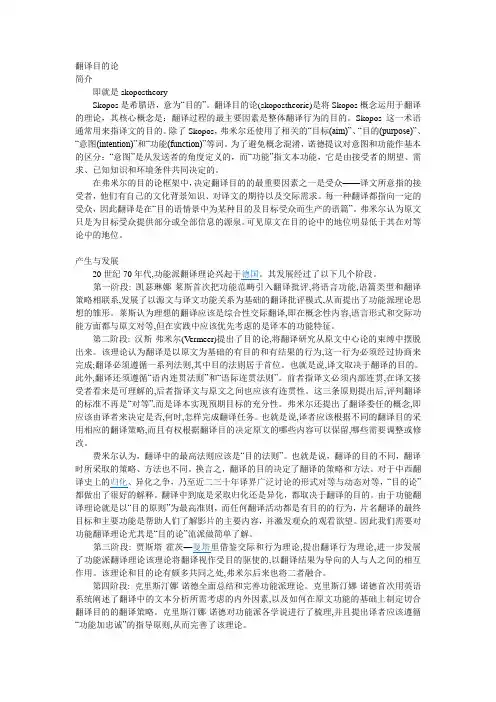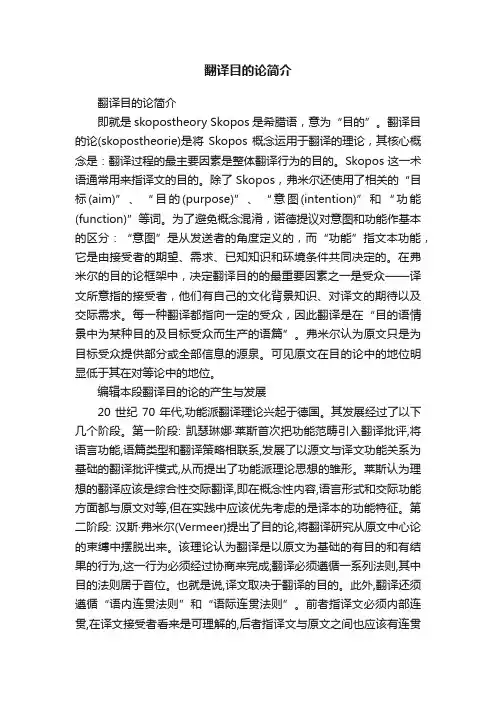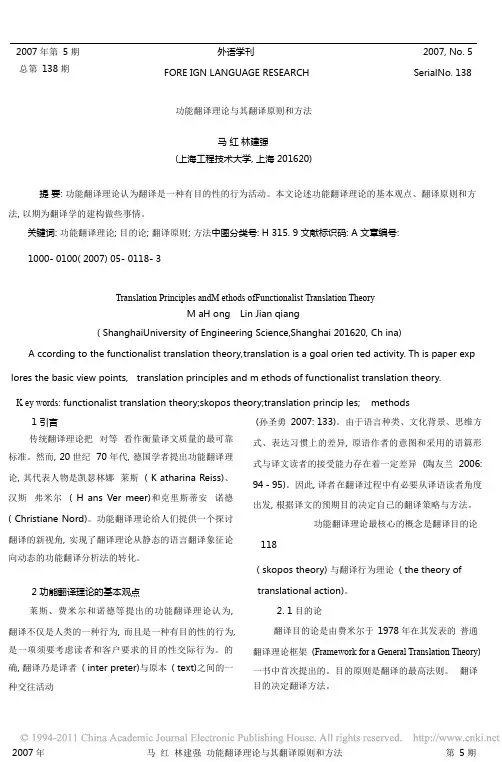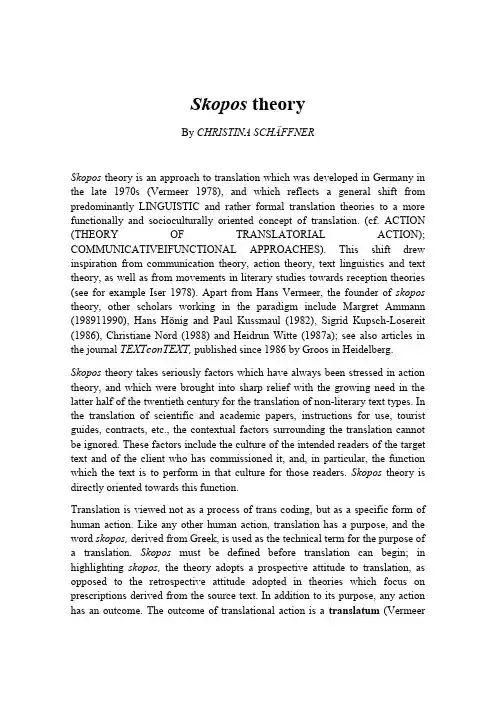skopostheory翻译功能目的论教程
- 格式:ppt
- 大小:580.50 KB
- 文档页数:29



简介即就是skopostheorySkopos是希腊语,意为“目的”。
翻译目的论(skopostheorie)是将Skopos概念运用于翻译的理论,其核心概念是:翻译过程的最主要因素是整体翻译行为的目的。
Skopos这一术语通常用来指译文的目的。
除了Skopos,弗米尔还使用了相关的“目标(aim)”、“目的(purpose)”、“意图(intention)”和“功能(function)”等词。
为了避免概念混淆,诺德提议对意图和功能作基本的区分:“意图”是从发送者的角度定义的,而“功能”指文本功能,它是由接受者的期望、需求、已知知识和环境条件共同决定的。
在弗米尔的目的论框架中,决定翻译目的的最重要因素之一是受众——译文所意指的接受者,他们有自己的文化背景知识、对译文的期待以及交际需求。
每一种翻译都指向一定的受众,因此翻译是在“目的语情景中为某种目的及目标受众而生产的语篇”。
弗米尔认为原文只是为目标受众提供部分或全部信息的源泉。
可见原文在目的论中的地位明显低于其在对等论中的地位。
产生与发展20世纪70年代,功能派翻译理论兴起于德国。
其发展经过了以下几个阶段。
第一阶段: 凯瑟琳娜·莱斯首次把功能范畴引入翻译批评,将语言功能,语篇类型和翻译策略相联系,发展了以源文与译文功能关系为基础的翻译批评模式,从而提出了功能派理论思想的雏形。
莱斯认为理想的翻译应该是综合性交际翻译,即在概念性内容,语言形式和交际功能方面都与原文对等,但在实践中应该优先考虑的是译本的功能特征。
第二阶段: 汉斯·弗米尔(Vermeer)提出了目的论,将翻译研究从原文中心论的束缚中摆脱出来。
该理论认为翻译是以原文为基础的有目的和有结果的行为,这一行为必须经过协商来完成;翻译必须遵循一系列法则,其中目的法则居于首位。
也就是说,译文取决于翻译的目的。
此外,翻译还须遵循“语内连贯法则”和“语际连贯法则”。
前者指译文必须内部连贯,在译文接受者看来是可理解的,后者指译文与原文之间也应该有连贯性。



翻译目的论简介翻译目的论简介即就是skopostheory Skopos是希腊语,意为“目的”。
翻译目的论(skopostheorie)是将Skopos概念运用于翻译的理论,其核心概念是:翻译过程的最主要因素是整体翻译行为的目的。
Skopos这一术语通常用来指译文的目的。
除了Skopos,弗米尔还使用了相关的“目标(aim)”、“目的(purpose)”、“意图(intention)”和“功能(function)”等词。
为了避免概念混淆,诺德提议对意图和功能作基本的区分:“意图”是从发送者的角度定义的,而“功能”指文本功能,它是由接受者的期望、需求、已知知识和环境条件共同决定的。
在弗米尔的目的论框架中,决定翻译目的的最重要因素之一是受众——译文所意指的接受者,他们有自己的文化背景知识、对译文的期待以及交际需求。
每一种翻译都指向一定的受众,因此翻译是在“目的语情景中为某种目的及目标受众而生产的语篇”。
弗米尔认为原文只是为目标受众提供部分或全部信息的源泉。
可见原文在目的论中的地位明显低于其在对等论中的地位。
编辑本段翻译目的论的产生与发展20世纪70年代,功能派翻译理论兴起于德国。
其发展经过了以下几个阶段。
第一阶段: 凯瑟琳娜·莱斯首次把功能范畴引入翻译批评,将语言功能,语篇类型和翻译策略相联系,发展了以源文与译文功能关系为基础的翻译批评模式,从而提出了功能派理论思想的雏形。
莱斯认为理想的翻译应该是综合性交际翻译,即在概念性内容,语言形式和交际功能方面都与原文对等,但在实践中应该优先考虑的是译本的功能特征。
第二阶段: 汉斯·弗米尔(Vermeer)提出了目的论,将翻译研究从原文中心论的束缚中摆脱出来。
该理论认为翻译是以原文为基础的有目的和有结果的行为,这一行为必须经过协商来完成;翻译必须遵循一系列法则,其中目的法则居于首位。
也就是说,译文取决于翻译的目的。
此外,翻译还须遵循“语内连贯法则”和“语际连贯法则”。

目的论的方法摘要:1.目的论的基本概念2.目的论的方法分类3.目的论在翻译中的应用4.目的论的局限性与挑战5.总结与展望正文:一、目的论的基本概念目的论(Skopos Theory)是德国翻译学者赫尔穆特·费尔米尔(Hans J.Vermeer)和凯瑟琳·雷斯(Katharina Reiss)在20世纪70年代提出的一种翻译理论。
它主张翻译活动应以实现译文读者的理解和接受为目标,强调翻译过程中译者的主观能动性和目标文化导向。
目的论认为,翻译不仅仅是传递原文信息,还应考虑到译文的目的、功能和接受者,从而使译文在不同文化背景下达到预期效果。
二、目的论的方法分类1.功能翻译方法:根据译文的功能和目的,采用合适的翻译策略。
例如,采用归化策略使译文符合目标语规范,或采用异化策略保留原文特色。
2.忠实翻译方法:在保证译文忠实于原文内容的同时,兼顾译文的可读性和接受性。
这种方法要求译者具备较高的语言素养和跨文化交际能力。
3.加译法:在原文基础上增加解释性词语或补充信息,以帮助目标语读者理解译文。
这种方法适用于原文中含有文化背景知识或专业术语的情况。
4.删译法:根据译文目的和读者需求,对原文进行删减或简化。
这种方法有助于提高译文的可读性和通顺性。
三、目的论在翻译中的应用1.文学翻译:在翻译文学作品时,目的论强调译者要充分考虑目标文化读者的审美习惯和接受程度。
例如,在翻译中国古代诗词时,译者应在保持原诗意境的基础上,采用恰当的翻译方法使之符合目标语诗歌的形式和风格。
2.商务翻译:在商务领域,目的论指导下的翻译注重译文的专业性、准确性和可操作性。
例如,产品说明、合同、广告等文本的翻译,都需要根据译文读者的需求和背景进行相应调整。
3.官方文件翻译:在政治、外交、法律等领域的官方文件翻译中,目的论强调译文的准确性和权威性。
同时,译者还需关注译文在不同文化间的可接受性,以避免因文化差异而产生的误解。
四、目的论的局限性与挑战1.主观性:目的论强调译者的主观能动性,但过度主观可能导致译文偏离原文,影响信息的传递。



功能翻译理论与其翻译原则和方法马红林建强(上海工程技术大学, 上海 201620)提要: 功能翻译理论认为翻译是一种有目的性的行为活动。
本文论述功能翻译理论的基本观点、翻译原则和方法, 以期为翻译学的建构做些事情。
关键词: 功能翻译理论; 目的论; 翻译原则; 方法中图分类号: H 315. 9 文献标识码: A 文章编号:1000- 0100( 2007) 05- 0118- 3Translation Principles andMethodsofFunctionalist Translation TheoryM aHong Lin Jian qiang( ShanghaiUniversity of Engineering Science,Shanghai 201620, China)A ccording to the functionalist translation theory, t ranslation is a goal orien ted activity. Th is paper explores the basic view points, translation principles and m ethods of functionalist translation theory.K ey words: functionalist translation theory;skopos theory;translation princip les; methods1 引言传统翻译理论把对等看作衡量译文质量的最可靠标准。
然而, 20世纪70年代, 德国学者提出功能翻译理论, 其代表人物是凯瑟林娜莱斯( K atharina Reiss)、汉斯弗米尔( H ansVermeer)和克里斯蒂安诺德( Christiane Nord)。
功能翻译理论给人们提供一个探讨翻译的新视角, 实现了翻译理论从静态的语言翻译象征论向动态的功能翻译分析法的转化。

Skopos theoryBy CHRISTINA SCHÄFFNERSkopos theory is an approach to translation which was developed in Germany in the late 1970s (Vermeer 1978), and which reflects a general shift from predominantly LINGUISTIC and rather formal translation theories to a more functionally and socioculturally oriented concept of translation. (cf. ACTION (THEORY OF TRANSLATORIAL ACTION); COMMUNICATIVEIFUNCTIONAL APPROACHES). This shift drew inspiration from communication theory, action theory, text linguistics and text theory, as well as from movements in literary studies towards reception theories (see for example Iser 1978). Apart from Hans Vermeer, the founder of skopos theory, other scholars working in the paradigm include Margret Ammann (198911990), Hans Hönig and Paul Kussmaul (1982), Sigrid Kupsch-Losereit (1986), Christiane Nord (1988) and Heidrun Witte (1987a); see also articles in the journal TEXTconTEXT, published since 1986 by Groos in Heidelberg. Skopos theory takes seriously factors which have always been stressed in action theory, and which were brought into sharp relief with the growing need in the latter half of the twentieth century for the translation of non-literary text types. In the translation of scientific and academic papers, instructions for use, tourist guides, contracts, etc., the contextual factors surrounding the translation cannot be ignored. These factors include the culture of the intended readers of the target text and of the client who has commissioned it, and, in particular, the function which the text is to perform in that culture for those readers. Skopos theory is directly oriented towards this function.Translation is viewed not as a process of trans coding, but as a specific form of human action. Like any other human action, translation has a purpose, and the word skopos, derived from Greek, is used as the technical term for the purpose of a translation. Skopos must be defined before translation can begin; in highlighting skopos, the theory adopts a prospective attitude to translation, as opposed to the retrospective attitude adopted in theories which focus on prescriptions derived from the source text. In addition to its purpose, any action has an outcome. The outcome of translational action is a translatum (Vermeer1979:174; translat in Reiss and Vermeer 198411991:2), a particular variety of target text.Vermeer's skopos theoryVermeer (1978:100) postulates that as a general rule it must be the intended purpose of the target text that determines translation methods and strategies. From this postulate, he derives the skopos rule: Human action (and its subcategory: translation) is determined by its purpose (skopos), and therefore it is a function of its purpose. The rule is formalized using the formula: IA(Trl) = f(Sk).The main point of this functional approach is the following: it is not the source text as such, or its effects on the source-text recipient, or the function assigned to it by the author, that determines the translation process, as is postulated by EQUIVALENCE-based translation theories, but the prospective function or skopos of the target text as determined by the initiator's, i.e. client's, needs. Consequently, the skopos is largely constrained by the target text user (reader/listener) and his/her situation and cultural background. Two further general rules are the coherence rule and the fidelity rule. The coherence rule stipulates that the target text must be sufficiently coherent to allow the intended users to comprehend it, given their assumed background knowledge and situational circumstances. The starting point for a translation is a text as part of a world continuum, written in the source language. It has to be translated into a target language in such a way that it becomes part of a world continuum which can be interpreted by the recipients as coherent with their situation (Vermeer 1978:100).The fidelity rule concerns intertextual coherence between translatum and source text, and stipulates merely that some relationship must remain between the two once the overriding principle of skopos and the rule of (intratextual) coherence have been satisfied.The general translation theory of Reiss and VermeerIn combining Vermeer's general skopos theory of 1978 with the specific translation theory developed by Katharina Reiss, Reiss and Vermeer (1984/1991) arrive at a translation theory that is sufficiently general(allgemeine Translationstheorie), and sufficiently complex, to cover a multitude of individual cases. They abstract from phenomena that are specific to individual cultures and languages an account of general factors determining the translation process, to which special theories that concern individual problems or subfields can be linked consistently.A text is viewed as an offer of information (Informationsangebot) made by a producer to a recipient. Translation is then characterized as offering information to members of one culture in their language (the target language and culture) about information originally offered in another language within another culture (the source language and culture). A translation is a secondary offer of information, imitating a primary offer of information. Or, to be more precise, the translator offers information about certain aspects of the source-text-in-situation, according to the target text skopos specified by the initiator (Reiss and Vermeer 1984/1991:76). Neither the selection made from the information offered in the source text, nor the specification of the skopos happens at random; rather, they are determined by the needs, expectations, etc. of the target-text receivers. Translation is by definition interlingual and intercultural, it involves both linguistic and cultural transfer; in other words, it is a culture-transcending process (Vermeer 1992:40).Since skopos varies with text receivers, the skopos of the target text and of the source text may be different. In cases where the skopos is the same for the two texts, Reiss and Vermeer (1984/1991:45) speak of Funktionskonstanz (functional constancy), whereas cases in which the skopos differs between the two texts undergo Funktionsanderung (change of function). In cases of the latter type, the standard for the translation will not be intertextual coherence with the source text, but adequacy or appropriateness to the skopos, which also determines the selection and arrangement of content.Although a translatum is not ipso facto a faithful imitation of the source text, fidelity to the source text is one possible or legitimate skopos. Skopos theory should not, therefore, be understood as promoting (extremely) free translation in all, or even a majority of cases.Although the terms 'skopos', 'purpose' and 'function' are often used interchangeably by Reiss and Vermeer (1984/1991), function is also used in a more specific sense which derives mainly from Reiss. In this sense, it is linked to aspects of genre (Textsorte) and text type (Texttyp). The source text can be assigned to a text type and to a genre, and in making this assignment, thetranslator can decide on the hierarchy of postulates which has to be observed during target-text production (Reiss and Vermeer 1984/1991:196).Reiss and Vermeer's text typology, based on Bühler (1934), includes the informative, the expressive and the operative text types, which derive from the descriptive, the expressive and the appellative functions of language, respectively. Such a typology is helpful mainly where functional constancy is required between source and target texts. However, both Vermeer (1989a) and Reiss (1988) have expressed reservations about the role of genre: the source text does not determine the genre of the target text, nor does the genre determine ipso facto the form of the target text, or, indeed, the skopos; rather, it is the skopos of the translation that determines the appropriate genre for the translatum, and the geme, being a consequence of the skopos, is secondary to it (Vermeer 1989a:187).Status of source text and target textAccording to skopos theory, then, translation is the production of a functionally appropriate target text based on an existing source text, and the relationship between the two texts is specified according to the skopos of the translation. One practical consequence of this theory is a reconceptualization of the status of the source text. It is up to the translator as the expert to decide what role a source text is to play in the translation action. The decisive factor is the precisely specified skopos, and the source text is just one constituent of the commission given to the translator. The translator is required to act consciously in accordance with the skopos, and skopos must be decided separately in each specific case. It may be ADAPTATION to the target culture, but it may also be to acquaint the reader with the source culture. The translator should know what the point of a translation is-that it has some goal-but that any given goal is only one among many possible goals. The important point is that no source text has only one correct or preferable translation (Vermeer 1989a:182), and that, consequently, every translation commission should explicitly or implicitly contain a statement of skopos. The skopos for the target text need not be identical with that attributed to the source text; but unless the skopos for the target text is specified, translation cannot, properly speaking, be carried out at all.Criticism of skopos theoryObjections to skopos theory mainly concern the definition of translation and the relationship between source text and target text.It has been argued that Reiss and Vermeer, in their attempt to establish a truly general and comprehensive translation theory, force totally disparate cases of text relations into a frame which they attempt to hold together by means of the notion of information offer (Schreitmüller 1994:105). But there should be a limit to what may legitimately be called translation as opposed to, for example, ADAPTATION. In translation proper (Koller 1990), the source text is the yardstick by which all translations must be measured, independently of the purpose for which they were produced.In this context it is also argued that, even though a translation may indeed fulfil its intended skopos perfectly well, it may nevertheless be assessed as inadequate on other counts, particularly as far as lexical, syntactic, or stylistic decisions on the microlevel are concerned (a point made by Chesterman 1994:153, who otherwise acknowledges the important contributions of skopos theory). Such objections come mainly from linguistically oriented approaches to translation that focus on bottom-up aspects of text production and reception. For example, Newmark (1991b:106) criticizes the oversimplification that is inherent in functionalism, the emphasis on the message at the expense of richness of meaning and to the detriment of the authority of the source-language text. However, proponents of skopos theory argue for a wide definition of translation (e.g. Reiss 1990). As soon as one asks for the purpose of a translation, strategies that are often listed under adaptation, for example reformulation, paraphrase and textual explication, will come in naturally as part of translation. And critics of micro level decisions usually lift the texts out of their respective environments for comparative purposes, ignoring their functional aspects.Reiss and Vermeer's cultural approach has also been judged less applicable to literary translation, due to the special status of a literary work of art. Snell-Hornby (1990:84) argues that the situation and function of literary texts are more complex than those of non-literary texts, and that style is a highly important factor. Therefore, although skopos theory is by no means irrelevant to literary translation, a number of points need rethinking before the theory can be made fully applicable to this genre.It is also possible to argue that to assign a skopos to a literary text is to restrict its possibilities of interpretation. In literary theory a distinction is often made between text as potential and text as realization, and skopos theory appears to seethe text only as realization, and not as a potential which can be used in different situations with different addressees and having different functions. However, Vermeer (1989a:181) argues that when a text is actually composed, this is done with an assumed function, or a restricted set of functions, in mind. Skopos theory does not deny that a text may be used in ways that had not been foreseen originally, only that a translatum is a text in its own right, with its own potential for use.Skopos theory has helped to bring the target text into focus. As a text, a translation is not primarily determined by a source text, but by its own skopos. This axiom provides a theoretical argument for describing translations in terms of original text production and against describing them in the more traditional terms of EQUIVALENCE with another text in another language (see also Jakobsen 1993:156). Translation is a DECISION MAKING process. The criteria for the decisions are provided by the skopos, i.e. the concrete purpose and aims in a concrete translation commission. The shift of focus away from source text reproduction to the more independent challenges of target-text production has brought innovation to translation theory. As attention has turned towards the functional aspects of translation and towards the explanation of translation decisions, the expertise and ethical responsibility of the translator have come to the fore. Translators have come to be viewed as target-text authors and have been released from the limitations and restrictions imposed by a narrowly defined concept of loyalty to the source text alone.Further readingAmmann 1989/1990; Newmark 1991b; Reiss 1986, 1988, 1990; Reiss and Vermeer 1984/1991; Vermeer 1978, 1982, 1989a, 1992.Baker M. (ed.) (1998/2001). Routledge Encyclopedia of Translation Studies. London: Routledge.。
目的论与歌曲翻译之标准一、本文概述随着全球化进程的加快,音乐作为文化交流的重要媒介,已经跨越国界,成为世界各地人们共同享受的艺术形式。
在这个过程中,歌曲翻译扮演着至关重要的角色,它不仅是语言转换的过程,更是文化传递的桥梁。
然而,歌曲翻译并非简单的直译,而是需要在保持原曲意境和情感的基础上,进行再创作的过程。
这就涉及到了翻译理论中的“目的论”。
本文旨在探讨目的论在歌曲翻译中的应用,以及如何在遵循目的论原则的基础上,构建歌曲翻译的标准。
通过对目的论的深入理解和实践应用,我们可以更好地指导歌曲翻译实践,促进音乐文化的国际交流与传播。
二、目的论概述目的论(Skopos Theory)是一种起源于20世纪70年代的翻译理论,由德国翻译学家汉斯·弗米尔(Hans Vermeer)提出,并由其学生诺德(Nord)进一步发展和完善。
该理论突破了传统等值翻译理论的束缚,强调翻译过程中的目的性和功能性,认为翻译行为所要达到的目的决定整个翻译过程,即“目的决定手段”。
目的论认为,翻译是一种有目的的跨语言、跨文化的交际活动,其首要原则是“目的原则”(Skopos Rule),即翻译应能在译语情境和文化中,按译语接受者期待的方式发生作用。
这一原则强调翻译应服务于特定的目的或功能,而非简单地追求原文与译文之间的对等。
在目的论的框架下,翻译策略和方法的选择取决于翻译的目的。
如果翻译的目的是为了传达原文的信息内容,那么译文可能更倾向于直译;而如果翻译的目的是为了实现某种特定的交际效果,那么译文可能会采用意译或改写的策略。
因此,目的论为翻译实践提供了更大的灵活性和自由度。
目的论还提出了“连贯性原则”(Coherence Rule)和“忠实性原则”(Fidelity Rule),作为对目的原则的补充。
连贯性原则要求译文必须符合语内连贯的标准,即译文具有可读性和可接受性;忠实性原则则要求译文与原文之间存在语际连贯,即译文应忠实于原文,但这种忠实并非逐字逐句的对应,而是指译文应传达原文的意图和信息。
目的论与翻译方法一、本文概述翻译作为一种跨文化、跨语言的交际活动,在全球化日益加深的今天显得尤为重要。
在这个过程中,翻译理论和方法的选择和应用直接关系到译文的质量和效果。
目的论作为一种重要的翻译理论,为翻译实践提供了全新的视角和思路。
本文旨在探讨目的论在翻译方法中的应用和影响,分析其在不同翻译情境中的适用性,以期为翻译实践提供理论支持和实际指导。
本文将简要介绍目的论的基本概念和核心思想,阐述其在翻译理论中的地位和作用。
本文将详细分析目的论指导下的翻译方法,包括直译、意译、音译等,并结合具体案例,探讨这些方法在不同翻译情境中的优势和局限性。
本文还将探讨目的论在文学翻译、科技翻译、商务翻译等不同领域的具体应用,以及在这些领域中可能遇到的问题和挑战。
本文将总结目的论在翻译方法中的价值和意义,展望其在未来翻译实践中的发展前景。
通过本文的研究,我们希望能够更深入地理解目的论在翻译方法中的重要性和作用,为翻译实践提供更为科学和有效的理论指导。
我们也期待通过本文的探讨,能够激发更多学者和翻译工作者对目的论的兴趣和研究,共同推动翻译事业的繁荣和发展。
二、目的论的基本概念目的论(Skopostheorie)是一种翻译理论,由德国翻译学家汉斯·弗米尔(Hans Vermeer)在20世纪70年代提出,并由他的学生诺德(Nord)进一步发展和完善。
这一理论的核心观念是,翻译是一种有目的的行为,这种行为的目的是由翻译活动的发起人决定的。
翻译的目的决定了翻译的策略和方法,即翻译的结果应首先满足译文的预期功能或目的。
在目的论中,翻译被视为一种人类行为,这种行为发生在特定的社会和文化环境中,并受到各种因素的影响。
这些因素包括翻译的目的、译文的接受者、译文的使用环境等。
因此,翻译不仅仅是语言之间的转换,更是一种跨文化、跨语言的交际行为。
目的论提出了三个基本原则,即目的原则、连贯性原则和忠实性原则。
其中,目的原则是首要原则,它强调翻译行为的目的决定翻译的策略和方法。
翻译目的论简介即就是skopostheory Skopos是希腊语,意为“目的”。
翻译目的论(skopostheorie)是将Skopos概念运用于翻译的理论,其核心概念是:翻译过程的最主要因素是整体翻译行为的目的。
Skopos这一术语通常用来指译文的目的。
除了Skopos,弗米尔还使用了相关的“目标(aim)”、“目的(purpose)”、“意图(intention)”和“功能(function)”等词。
为了避免概念混淆,诺德提议对意图和功能作基本的区分:“意图”是从发送者的角度定义的,而“功能”指文本功能,它是由接受者的期望、需求、已知知识和环境条件共同决定的。
在弗米尔的目的论框架中,决定翻译目的的最重要因素之一是受众——译文所意指的接受者,他们有自己的文化背景知识、对译文的期待以及交际需求。
每一种翻译都指向一定的受众,因此翻译是在“目的语情景中为某种目的及目标受众而生产的语篇”。
弗米尔认为原文只是为目标受众提供部分或全部信息的源泉。
可见原文在目的论中的地位明显低于其在对等论中的地位。
编辑本段翻译目的论的产生与发展20世纪70年代,功能派翻译理论兴起于德国。
其发展经过了以下几个阶段。
第一阶段: 凯瑟琳娜·莱斯首次把功能范畴引入翻译批评,将语言功能,语篇类型和翻译策略相联系,发展了以源文与译文功能关系为基础的翻译批评模式,从而提出了功能派理论思想的雏形。
莱斯认为理想的翻译应该是综合性交际翻译,即在概念性内容,语言形式和交际功能方面都与原文对等,但在实践中应该优先考虑的是译本的功能特征。
第二阶段: 汉斯·弗米尔(Vermeer)提出了目的论,将翻译研究从原文中心论的束缚中摆脱出来。
该理论认为翻译是以原文为基础的有目的和有结果的行为,这一行为必须经过协商来完成;翻译必须遵循一系列法则,其中目的法则居于首位。
也就是说,译文取决于翻译的目的。
此外,翻译还须遵循“语内连贯法则”和“语际连贯法则”。
“翻译目的论(skopos theory)是将Skopos概念运用于翻译的理论,其核心概念是:翻译过程的最主要因素是整体翻译行为的目的。
”
目的论即翻译目的论,包括三个原则:目的法则、连贯性原则、忠实原则
一、目的法则
翻译“目的论”认为目的性原则是翻译的首要原则。
在翻译过程中起主要作用的是译文在译语文化中所要达到的交际目的。
目的性原则要求翻译的过程应该以译文在译语文化中达到它预期的功能为标准,翻译只是以原语文本为基础的一种翻译行为。
译者在整个翻译过程中不再以对等理论所强调的原文及其功能为标准,而是注重译文在译语文化环境所要实现的一种或几种交际功能。
目的性原则是决定翻译过程的根本原则。
二、连贯性原则
译文必须语内连贯,换言之,译文必须对于具有目的语交际环境和知识背景的接受者是可理解的。
也就是说“译文必须能让接受者理解,并在目的语交际环境和文化中有意义”。
三、忠实原则
在目的论中,忠实性法则仅仅是指原文和译文中应该存在某种对应关系,并不要求原文和译文在内容上一字不差。
忠实的程度与形式取决于译者对原文的理解及翻译的目的。
诺德认为,“在能够达到译文预期功能的情况下,译者应尽可能保持译文与原文在语言特色上的一致。
”。
Skopos TheoryFor Vermeer, translation is a type of human action, an intentional, purposeful behavior that takes place in a given situation. It is a form of translation action based on a source text. He holds that any action has an aim, a purpose, so does translation activity. The Greek word “skopos”, which was introduced into translation theory by Vermeer in the 1970s, is a technique term for the goal or purpose of a translation, that is what a translator is aiming at in the translation process.The essence of the theory: The prime principle determining any translation process is the purpose(skopos)of the overall translation action,which is regarded as the central theory by th e German Functionalism.The advantage of skopos theory is that it allows the possibility of the same text being tra nslated in different ways according to the purpose of the TT and the commission which is giv en to the translator.It includes three principles:skopos rule,coherence rule,and fidelity rule.Skopos rule ex plains that translation is determined by purpose.Coherence rule mainly focus on the coherenc e of form and meaning.Fidelity rule is faithful to the original writing.If there is contradiction among three principles,skopos rule should be put in the first place.skopos rule:According to skopos theory, principle of all translation activities follow the "objective principle", namely the translation should be in language context and culture, according to the target text receivers expected function types. The purpose of translation is to determine the whole process of translation, that is to say, the method of determining the outcome. But the translation activities can have multiple purposes, which further divided into three categories: (1) the basic purpose of the translator ; (2) the communicative purpose of the translation (such as enlightening); (3) to use some special means of translation purpose (such as to illustrate the special grammatical structure a language in the literal way) according to its structure. However, under normal circumstances, the "objective" refers to the communicative purpose of the translation, namely "translation of the target readers in the target language in the social cultural context of communicative function". (Venuti:2001) therefore, the translator should make clear its specific purpose in a given translation context, and in accordance with the objective to determine the - between literal translation and free translation or between what the translation method.Coherence rule:It refers to the translation must conform to inter-textual coherence standard, namely with readability and acceptability, can make the recipient understand and have significance in the target culture and the communicative context. Fidelity rule means that there should be interlingual coherence between the original and the translation (inter - textual coherence). This is equivalent to what other translation theories call fidelity to the original text, but the degree and form of faithfulness with the source text depends on the purpose of the translation and the translator's understanding of the original text.Loyalty rule:The principle of loyalty was put forward by Nord. She found that Skopostheorie has two drawbacks: first, because of the differences of cultural patterns, people with different cultural backgrounds have different views on good translation; in addition, if the intention principlerequired by the communicative purpose of the translation and the original author of the opposite, then we will abide by the objective principle and principle of faithfulness. Therefore, Nord put forward the principle of loyalty to solve the relationship between cultural differences and the participants in the translation process. Nord believes that the translator has a moral obligation to the receiver and must explain to them what he has done and why. This is part of the principle of loyalty. On the other hand, the translator is required to be loyal to the original author. The translator should respect the original author and coordinate the target text and the author's intention. Therefore, the principle of loyalty focuses on the relationship between the translator and the author, the customer, the receiver and the participants in the translation process. Nord proposed that the translator should follow the guiding principle of "function plus loyalty", that let the theory become perfecting.Skopostheorie has a wide range of applications, not only for translation, but also for interpretation, especially for interpreting studies. The translation process is a complicated process involving multiple choice, skopos theory highlights the subjectivity of the translator, the translator to get rid of the shackles of the traditional equivalence theory, the translation purpose as the starting point and fundamental task of translation, has greatly changed our original concept of translation. From the translation strategy, the translation method, to the choice of the form and content of the original text, to the production of the target text, the translation purpose is used as the reference.。
翻译目的论(skopos theory)是将Skopos概念运用于翻译的理论,其核心概念是:翻译过程的最主要因素是整体翻译行为的目的。
目的原则(skopos rule)目的论认为,所有翻译活动遵循的首要原则是“目的原则”,即翻译应能在译入语情境和文化中,按译入语接受者期待的方式发生作用。
翻译行为所要达到的目的决定整个翻译行为的过程,即结果决定方法。
但翻译活动可以有多个目的,这些目的进一步划分为三类:(1)译者的基本目的(如谋生);(2)译文的交际目的(如启迪读者);(3)使用某种特殊的翻译手段所要达到的目的(如为了说明某种语言中的语法结构的特殊之处采用按其结构直译的方式)。
但是,通常情况下,“目的”指的是译文的交际目的,即“译文在译入语社会文化语境中对译入语读者产生的交际功能”。
(Venuti:2001)因此,译者应在给定的翻译语境中明确其特定目的,并根据这一目的来决定采用何种翻译方法—直译、意译或介于两者之间。
连贯性原则连贯性(coherence rule)指译文必须符合语内连贯(intra—textual coherence)的标准,即译文具有可读性和可接受性,能够使接受者理解并在译入语文化及使用译文的交际语境中有意义。
忠实性原则忠实性原则(fidelity rule)指原文与译文之间应该存在语际连贯一致(inter—textual coherence)。
这相当于其他翻译理论所谓的忠实于原文,但与原文忠实的程度和形式取决于译文的目的和译者对原文的理解。
总之,这三大原则构成了翻译目的论的基本原则,但是连贯性原则、忠实性原则必须服从于目的原则,这是目的论的首要原则。
Skopos这一术语通常用来指译文的目的,Skopos一词来源于希腊语目的“Skopos”。
除了Skopos,弗米尔还使用了相关的“目标(aim)”、“目的(purpose)”、“意图(intention)”和“功能(function)”等词。